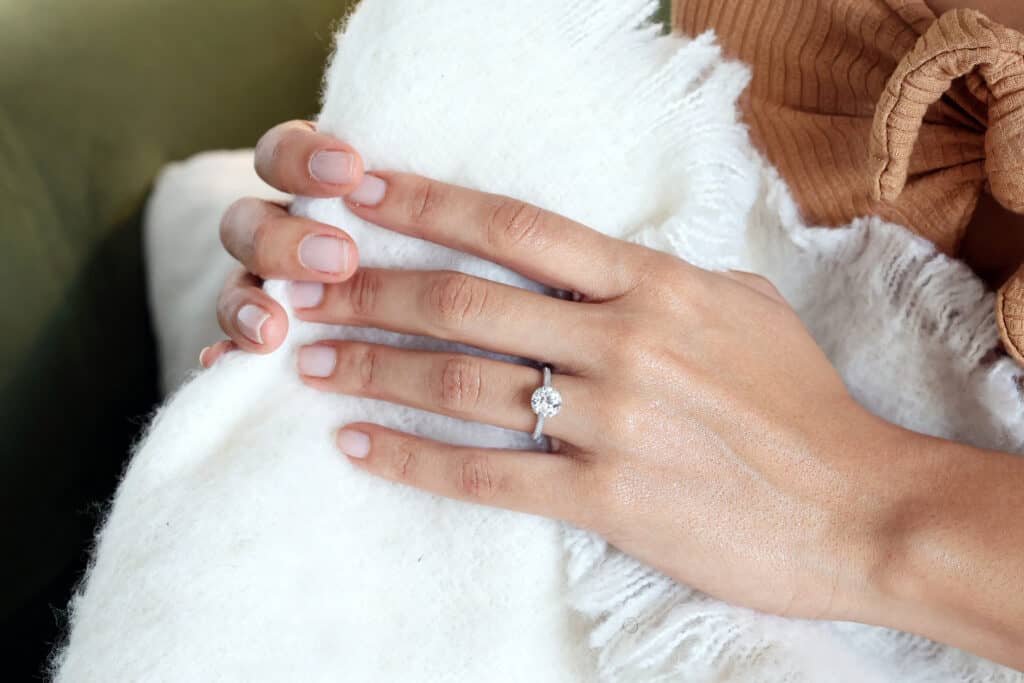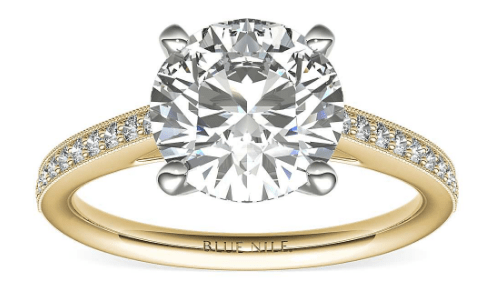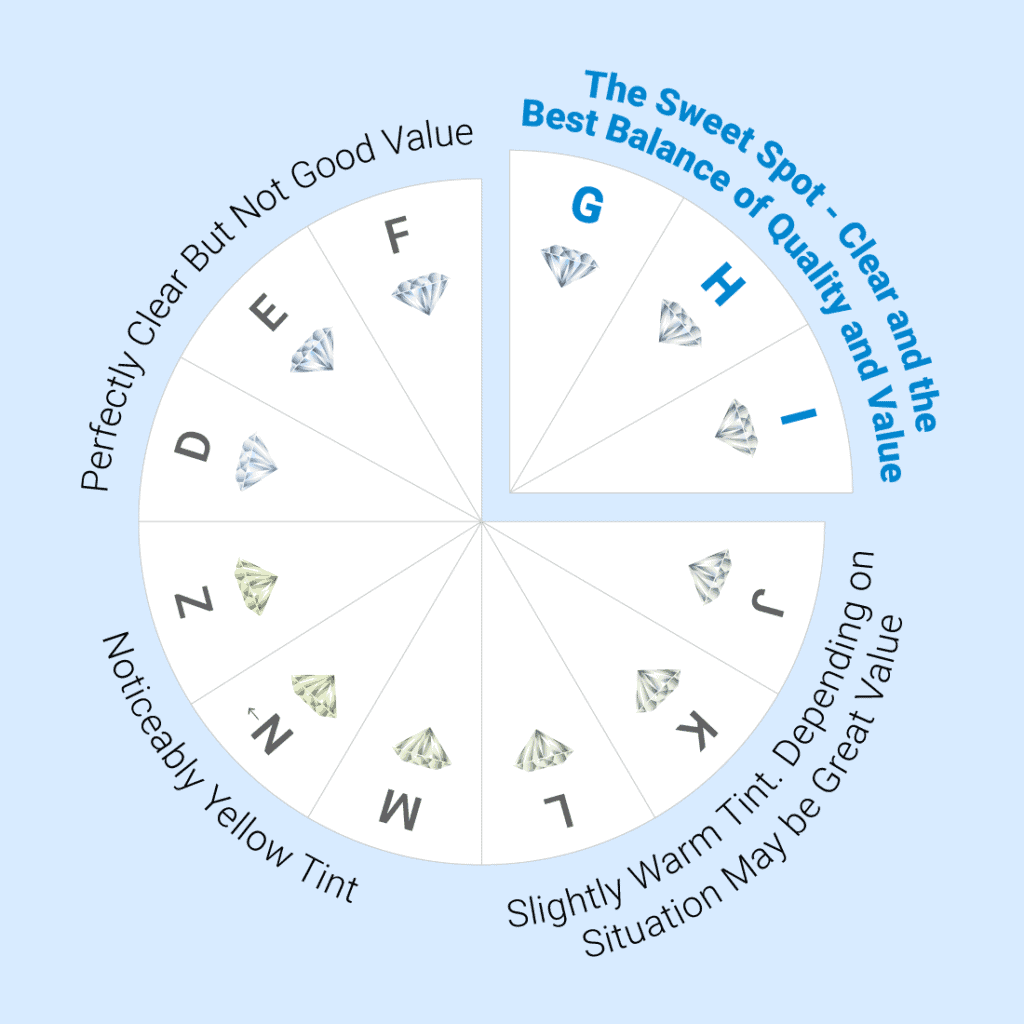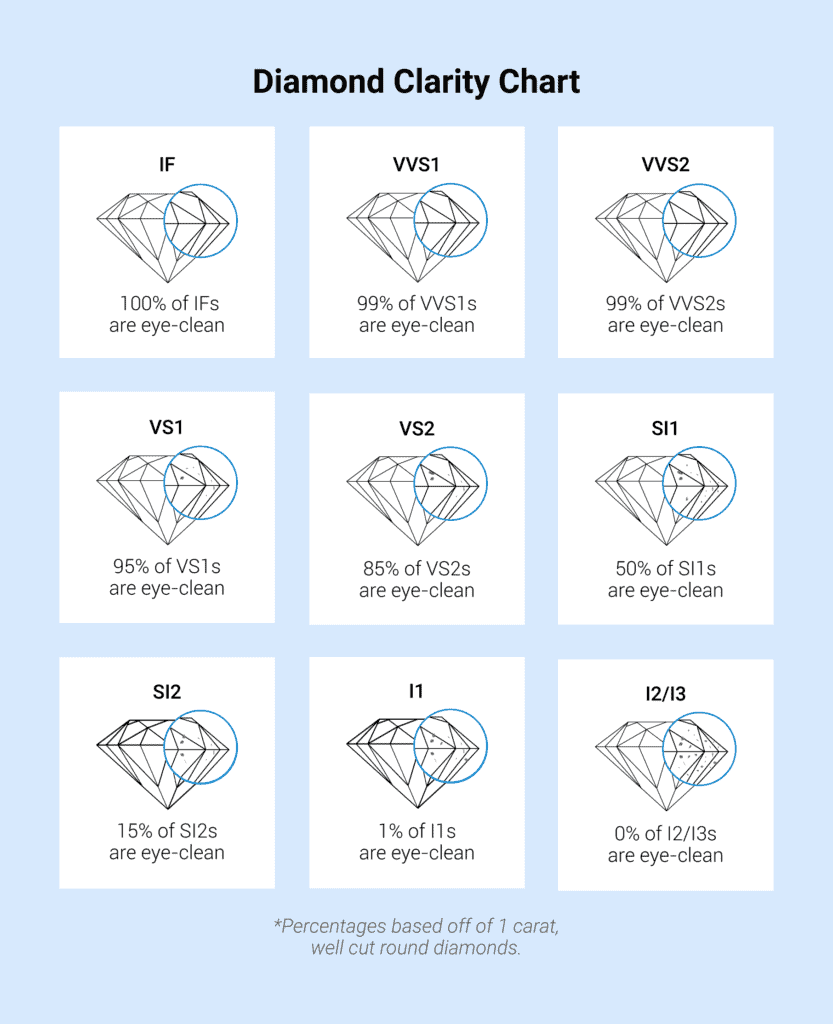Buying a 2.50 Carat Diamond Ring
A complete guide to get you the perfect 2.50 ct diamond for your engagement ring
A complete guide to get you the perfect 2.50 ct diamond for your engagement ring
If you’re looking for a large, elegant and impressive engagement ring, a 2.50 carat diamond is sure to make an impression.
For a 2.50ct diamond, we recommend selecting a diamond that’s eye clean, with a clarity grade of VS1/VS2 or better. Choose a color grade in the G to I range for a diamond that appears colorless to the naked eye while costing less than a colorless D, E or F grade stone. We also recommend limiting your choices to diamonds with an excellent or ideal cut grade, as cut quality has the biggest impact on a diamond’s appearance.
The price of a diamond ring with a 2.50-carat stone can range from a minimum of $10,000 to upwards of $75,000, depending on the diamond’s quality and the setting style you opt for. The place of purchase can also influence the cost.

What is a 2.50 carat diamond?
How much does a 2.50 carat diamond ring cost?
What is the difference between a 2 carat and 2.50 carat diamond ring?
What tips should I follow when buying a 2.50 carat diamond ring?
What style ring works best with a 2.50 carat diamond?
Where should I buy a 2.50 carat diamond ring from?
Why you should trust us
To get the best deal, buy from a trusted online vendor such as James Allen, Blue Nile. These vendors all offer large selections of 2.50ct diamonds and settings, with highly competitive pricing and some of the best customer service in the industry.
If you want personalized help choosing your diamond, feel free to contact us and we’ll help you find the best 2.50 carat diamond for your tastes and budget.

A 2.50 carat diamond engagement ring can look truly stunning, with a beautiful appearance and exceptional brilliance, plus a large size that gives it real presence on your fiancé-to-be’s finger.
Diamonds in the 2.50 carat range are significantly larger than the average diamond used in an engagement ring. As such, they’re priced to match. When you’re buying a large diamond like this, it’s especially important to check that it’s a high-quality stone that’s free of issues such as coloration or inclusions.
The large size of a 2.50 carat diamond means that any blemishes, which might not be visible on a smaller diamond, can be more visually obvious.
For example, this 2.50 carat diamond from James Allen looks stunning, while this diamond from Blue Nile of basically an identical carat weight and a similar price has obvious issues that make it a comparatively poor choice.
Below, we’ve explained what a 2.50 carat diamond is, as well as how a 2.50ct diamond stacks up next to other common diamond carat weights. We’ve also offered our expert advice on what you should look for if you’d like to purchase a 2.50ct diamond engagement ring.
A 2.50 carat diamond is a diamond with a carat weight of 2.50 carats, or 500 milligrams (half of a gram). A typical 2.50ct round diamond weighs just over half as much as the average raisin and measures just under nine millimeters in diameter.
2.50ct diamonds are significantly larger than average. They’re also quite scarce. Because of this, it’s uncommon to find a high-quality, well-cut diamond of this carat weight in a local jewelry store or from a brick-and-mortar diamond jeweler.
Instead, you’ll find the best range of high-quality 2.50 carat diamond rings online from the trusted vendors we’ve listed further down the page.
Like other diamonds, 2.50ct diamonds can vary hugely in appearance, with some diamonds displaying obvious coloration, inclusions and other imperfections, and others appearing largely colorless and free of visible issues.
As we’ve discussed elsewhere on this website, evaluating the four Cs will help you get the best deal on a diamond of this carat weight. With diamonds, the highest price doesn’t always mean the best, most beautiful diamond.
A 2.50 carat diamond ring can vary in price from as little as $10,000 to $75,000 or more based on the quality of the diamond and the type of setting you choose. Cost can also vary depending where you buy your diamond. If you want we have an article discussing where to know where to buy a diamond ring,
A variety of factors affect the price of a diamond. Of these, the four most significant are the 4Cs of a diamond — a term that refers to a diamond’s cut quality, clarity, color and carat weight. The higher the quality of the diamond in terms of cut, color and clarity, the more it will usually cost. You can check out the price differences across different carat weights using our diamond price calculator.
The Four C’s:
”Because of their rarity, large diamonds command a premium – so much so that the difference in price isn’t geometric but exponential. In other words, a 1.00 ct diamond will cost much more per carat than a 0.50 ct diamond. A 2.00 ct diamond will have a much higher per-carat price than a 1.00 ct diamond.” Gemological Institute of America (GIA)
This means that you’ll pay significantly more per carat for a 2.50 carat diamond than you would for a diamond in the 1.00 carat range.
For example, you can view this 2.51 carat diamond on Blue Nile. This diamond has an ideal cut, VVS1 clarity and a D color grade, all of which are very good things. It’s a gorgeous diamond with a high price of $50,250 to match.
There’s no question that this is a beautiful diamond, but it comes with a significant premium in terms of pricing compared to diamonds that are great looking but have slightly lower color and clarity grades.
On the other hand, this 2.51 carat, ideal cut, VS1 clarity, H color diamond from Blue Nile also looks impressive and costs far less at $29,390.

At the bottom end of the scale, you have diamonds like this one from James Allen, which has a clearly visible tint and poor clarity and, as such, only costs $7,150. Despite being very inexpensive, this diamond isn’t necessarily good value, as its flaws are obvious.
The last of the four Cs is carat weight. Although we’re discussing 2.50 carat diamonds here, it’s important to explain how carat weight affects pricing for diamonds as a whole.
Diamond prices increase exponentially with carat weight. This means that you’ll need to spend more both in total and per carat for a 2.50ct diamond than you would for, for example, a 1.50 carat diamond ring.
We’ve explained the relationship between diamond carat weight and price in more detail in our guide to diamond prices. In short, the higher the diamond’s carat weight, the more you’ll spend per carat.
In addition to the four Cs, there are several other factors that each play a role in determining a 2.50 carat diamond’s value. However, these are relatively minor in comparison.
When you’re buying an engagement ring, you’ll also need to factor in the cost of the setting you choose for the diamond.
The type of ring you choose and the metal it’s made from will all affect the total price you’ll pay for the diamond ring. Engagement ring settings can range in price from a few hundred dollars to thousands of dollars for more ornate settings with pavé, halo or side-stone diamonds.
With a large diamond like this, the setting itself will only account for a relatively small percentage of the total price. Still, it’s important to account for this if you have a specific budget.
Check out our guide to $25k engagement rings for inspiration.

Because they’re similar in size and price, 2.50 carat diamonds are often compared to diamonds in the 2 carat size range (check the 2 carat diamond price here). Here are the key differences:
Because of this limited availability, it may be harder to find a diamond that meets your specifications in the 2.50ct range. If you need help choosing a diamond, feel free to contact us.
Buying the right 2.50 carat diamond can be a more difficult process than shopping for a smaller diamond, such as a diamond in the 1 carat or 1.50 carat range.
This is because the large size of the diamond makes flaws, such as inclusions, blemishes or a noticeable color, easier to see. There’s also a much smaller selection of diamonds in this carat weight range, meaning you’ll need to be more selective to get the best possible deal.
Below, we’ve offered our expert tips to help you buy the best 2.50ct diamond for your tastes and preferences, all without spending more than you need to:
As we’ve explained in our guide to diamond cut, the cut quality of a diamond has the biggest impact on its beauty. A well-cut diamond will reflect light extremely well, resulting in brilliance and fire, whereas a poorly cut diamond will look dull and lifeless in comparison.
This is particularly important for a large diamond in the 2 to 2.50 carat range, as a good quality cut not only enhances the diamond’s brilliance but also helps to conceal color and inclusions (two issues that we’ve covered in more detail further down the page).
To ensure you buy a diamond with a high-quality cut, we recommend restricting your search to diamonds with an “ideal” or “excellent” cut quality. You can do this easily using the search tools on websites like James Allen and Blue Nile.
You should only ever buy a diamond that’s sold with a GIA certificate. As we’ve covered in our guide to diamond certification, this is the most reputable diamond grading entity, meaning you can rely on them to provide an objective, fair evaluation for each diamond.
Other certifications aren’t as reliable and tend to overstate a diamond’s quality. We recommend doing this for all diamonds, but it’s particularly important for a large, valuable diamond in the 2.50ct range.
Diamonds are graded for color on a scale that runs from D to Z. The closer a diamond’s grade is to D, the less color it displays. As you go further down the scale, a diamond may display a slight yellow or brown tint. In lower color grades, this tint may be visible to the naked eye.
As we’ve explained in our guide to diamond color, it usually isn’t worth overpaying for a diamond with a D, E or F color grade. Instead, we recommend choosing a diamond that looks colorless to the naked eye in relation to its setting.

With a large diamond in the 2.50 carat range, color can often be more visible than it would be in a small diamond. This is because a large diamond has a bigger table, allowing you to more easily see its internal color.
For a 2.50ct diamond, we generally recommend choosing something with a color grade in the G to I range. Diamonds in this color range are graded as nearly colorless and, to the naked eye, look just as white as diamonds in the D to F color range.

Buying a near-colorless diamond will allow you to save a significant amount of money compared to buying one that’s truly colorless. To the naked eye in regular lighting conditions, these two diamonds look identical. Set in a ring, it’s very difficult to perceive any difference between them without bright lighting and a jeweler’s loupe.
If you plan to choose a colored setting, such as a yellow or rose gold engagement ring, you can drop even further down the color scale. This is because the color of the setting will conceal any color in the diamond.
A superbly cut K color 2.50ct will look beautiful and cost about $15,000 – a tiny fraction as much as the D color diamond mentioned above. In a yellow or rose gold engagement ring, it will have a warm, elegant look without any obvious coloration.
As we mentioned above, the large table size (the flat, top surface) of diamonds in the 2.50 carat range means they’re more likely to display inclusions and blemishes than smaller diamonds.
This makes it important to check the diamond clarity before you make a purchase. For a 2.50ct diamond, we recommend a minimum clarity grade of VS1 to avoid buying a diamond that has obvious, visible flaws.
Like with color, there’s no reason to pay for flawless clarity. Instead, look at diamonds within the VS1, VVS1 and VVS2 clarity grades. Check each diamond for visible inclusions and purchase a diamond that’s eye-clean, meaning it doesn’t have any blemishes that the naked eye can see.

In some cases, you might be able to drop down to the VS2 or even SI1 clarity grade if the diamond only has small, barely-visible inclusions that are located close to its edges.
“Many inclusions and blemishes are too tiny to be seen by anyone other than a trained diamond grader. To the naked eye, a VS1 and an SI2 diamond may look exactly the same, but these diamonds are quite different in terms of overall quality. This is why expert and accurate assessment of diamond clarity is extremely important.” Gemological Institute of America (GIA)
It’s important to check every diamond with your eye, as the clarity grade listed on the diamond’s GIA certificate doesn’t always tell the full story. If you need help, you can contact us and we’ll help you find an eye-clean diamond in your desired shape and price range.
We have recently developed Ringo, a patented artificial intelligence model, that can examine videos of diamonds and determine if they are eye-clean. Ringo will also filter for other parameters like making sure the diamond is well-cut, doesn’t have fluorescence issues and will match the style setting you choose. You can access it here and give it a go.
There are a wide variety of styles to pick from when you’re in the market for a 2.5 carat diamond ring. When it comes to choosing a setting style or picking between different diamond shapes, you need to take the personality and style preferences of your fiancé-to-be into account. It’s difficult to say that one particular style is better or worse than another.
The most popular style of engagement ring is a simple solitaire setting. A solitaire engagement ring is also likely to be the most affordable option, allowing you to spend less on a 2.50 carat engagement ring, or put more money towards a higher-quality diamond.
However, if you want a little more flair, you can go with a halo or pavé setting, or a flashy setting like this White Gold Pavé Step Engagement Ring from James Allen.
You’ve also got the choice of 2.5 carat diamonds in a variety of shapes, which offer a more unique look than the classic round diamond (this is not to say that a round diamond is a bad choice in any way).
The best way to narrow the choices down is to shop around, view different styles and shapes, and see which you think will suit your partner the best. Check out these examples for inspiration, then read on to learn a little more about what you can choose from with a 2.50 carat diamond ring.
A solitaire setting is the most common, and most popular, style of engagement ring. Solitaire rings are popular for a reason – they’re simple, elegant, timeless, and affordable.
In a solitaire setting, the ring features just one single diamond – in this case, a 2.50 carat diamond. This diamond is held in place usually by 4 or 6 metal prongs, designed to keep it secure with minimal visual obstruction.
The setting lets enough light in, which reflects through the diamond and allows it to display maximum fire and brilliance.
Solitaire settings work with any diamond shape, allowing you a great deal of flexibility and freedom to put together a unique engagement ring for the special person in your life.
Oval Shaped Diamonds offer the fire and brilliance of a round diamond, with a unique shape that helps the ring truly stand out. A well-proportioned Oval Diamond can be extremely beautiful.
The elongated shape and large table size of Oval Diamonds make them appear larger than their carat weight, which again is a strong selling point that allows you to pay less for what seems like a larger diamond.
Here are some 2.5 Carat Oval Diamond Ring examples to use as inspiration:


As the second most popular diamond shape (after the Round Brilliant), the Princess Cut delivers intense fire and brilliance in a square outline. Princess Cuts have a higher yield in comparison to Round Brilliant Diamonds (meaning the percentage of the rough diamond that remains after cutting), so generally they are a lower price per carat.
Princess Cut Diamonds offer a unique look, without sacrificing anything in brilliance, and fit great with solitaire settings.
Check out these 2.5 Carat Princess Cut Diamond Rings as examples:


Cushion Cut Diamonds provide a great amount of all-round fire, and a shape that falls in between round and square diamonds. Cushion Cuts are square or rectangular, but with rounded edges, giving it an extremely unique look.
Cushion Cut Diamonds fit well in a remarkable range of settings, due to their hybrid rounded/square shape, and the way they fit with both classic and modern styles.
Here are some 2.5 Carat Cushion Cut Diamond Ring examples to get your search started:


We strongly recommend buying diamond jewelry online. As we’ve explained in our guide to the best places to buy an engagement ring, shopping online offers several advantages compared to buying a 2.50 carat diamond from a local jewelry store:
With this explained, here are some of the vendors we recommend using if you want to buy a 2.50 carat diamond ring online:
A 2.5 carat ring is a big investment, so it’s important to take your time making a decision. Consider all the options available, to ensure you get the best value.
Don’t compromise on cut grade, focus on finding an eye-clean, colorless diamond, and make sure to shop with a reputable vendor like those we talked about above. Online stores such as James Allen and Blue Nile have a large range of 2.50 carat GIA diamonds to choose from, which should allow you to find one that’s perfect for you.
Need expert help buying a 2.5 carat diamond engagement ring? Contact us and our experts will help you find the best diamond for your tastes and budget.




Before you buy a diamond, get personal buying advice from industry veterans. We'll help you get the best diamond for the money.
DISCLAIMER: We don't use your email for marketing. Period.
A diamonds’ price is determined primarily by the 4 Cs of the diamond. On the wholesale level, diamond prices are first based on a diamond shape and
Buying an engagement ring is often one of the first major purchases in a person's life. The process can be fraught with tension as there are so m
A wide range of 1 carat diamonds exist both in online markets and local diamond jewelry stores. Not only are there significant differences in beauty
Please enter your email address to receive your 25% off coupon code:
Here is your coupon code: GFDSF3GF